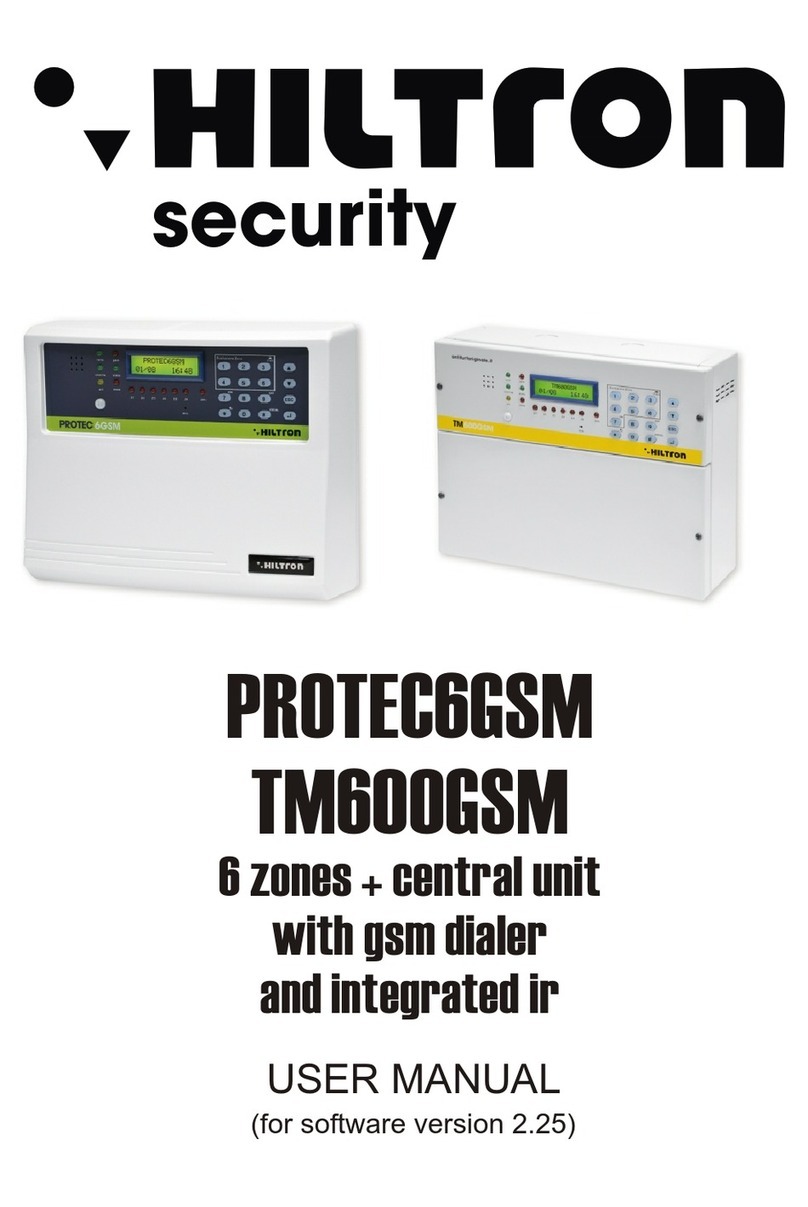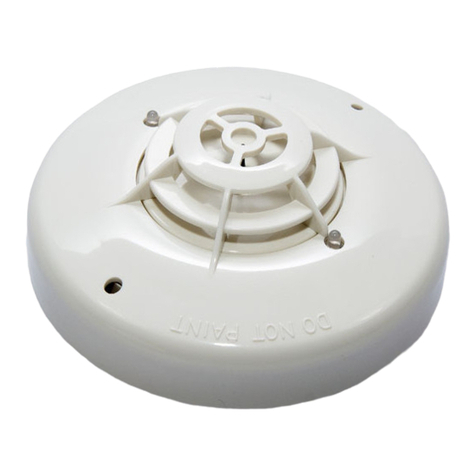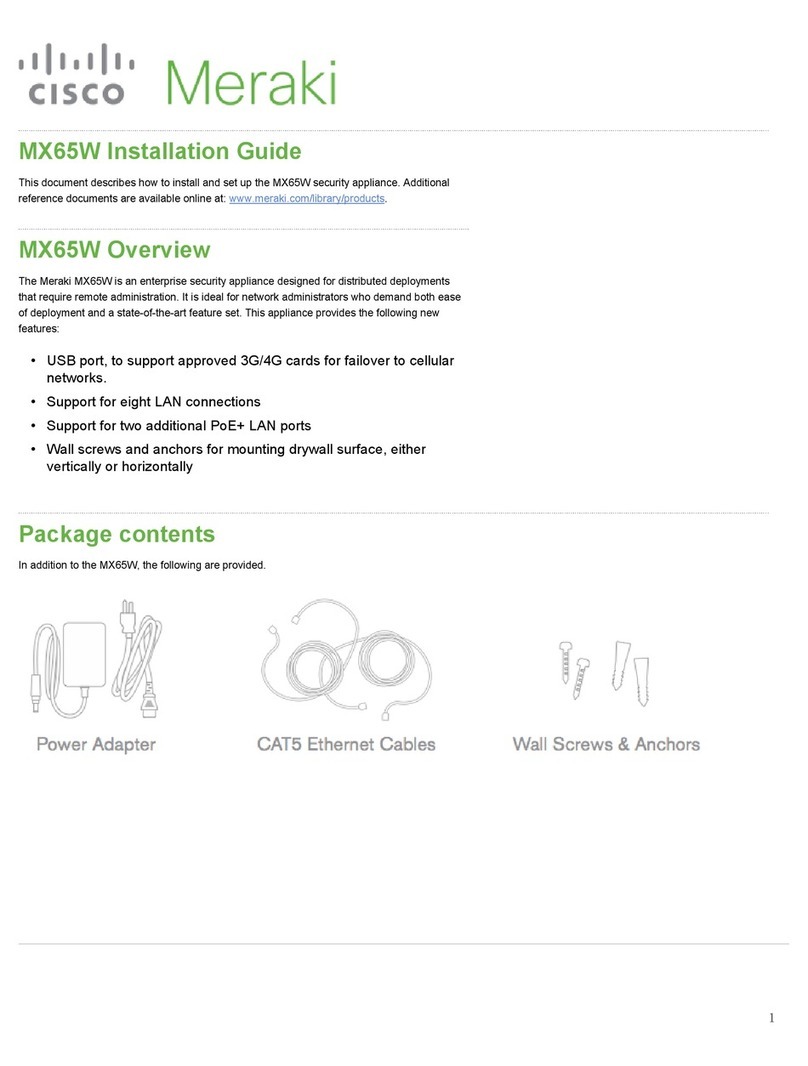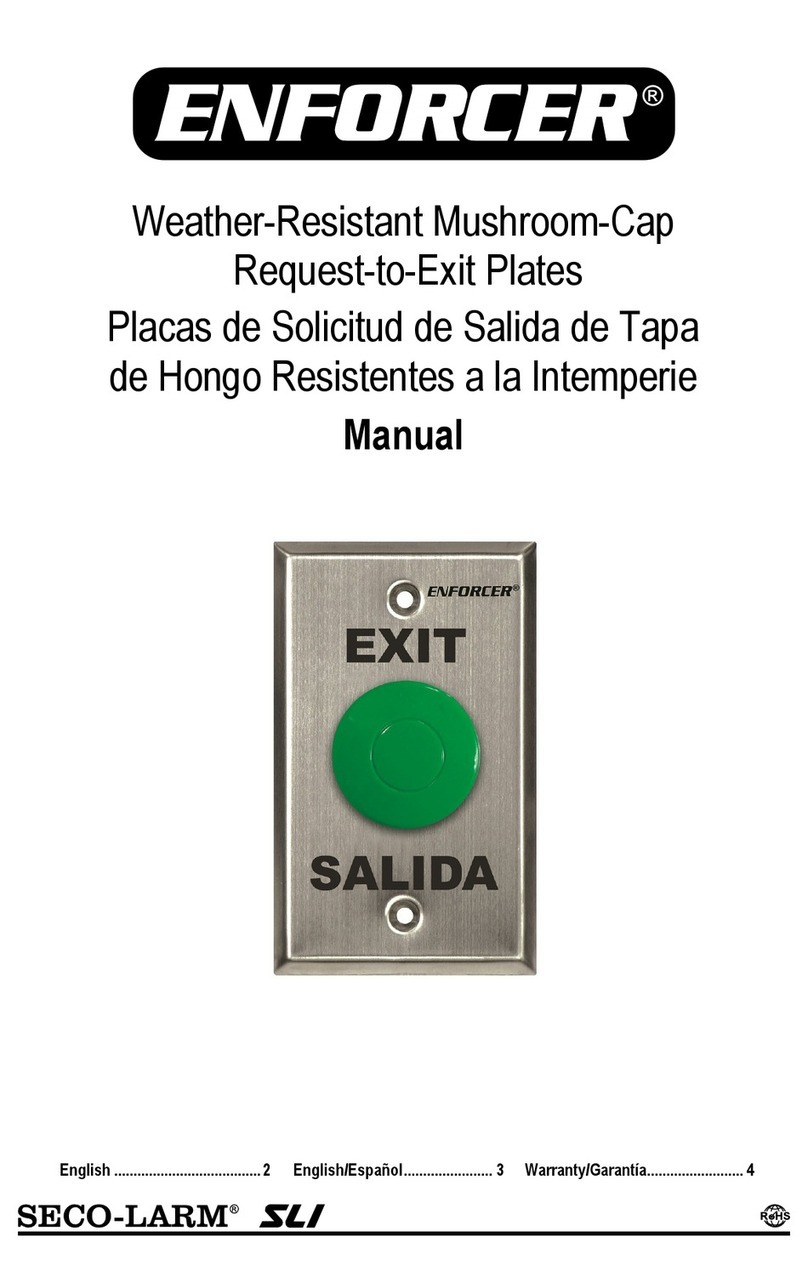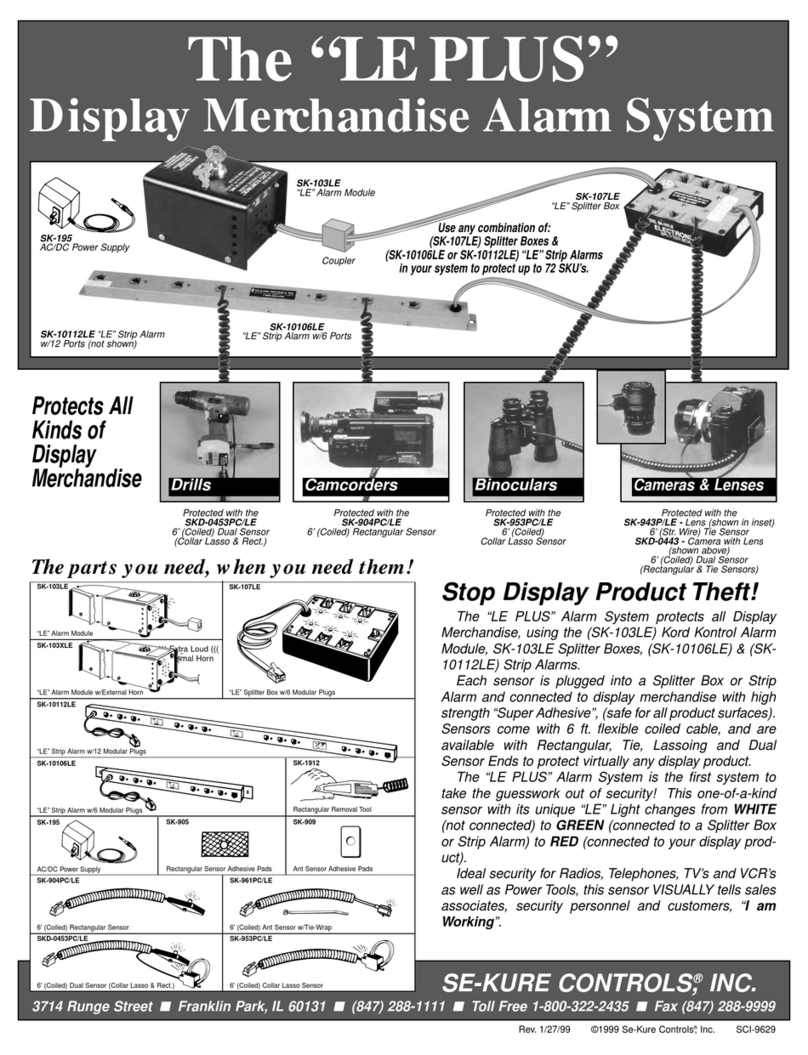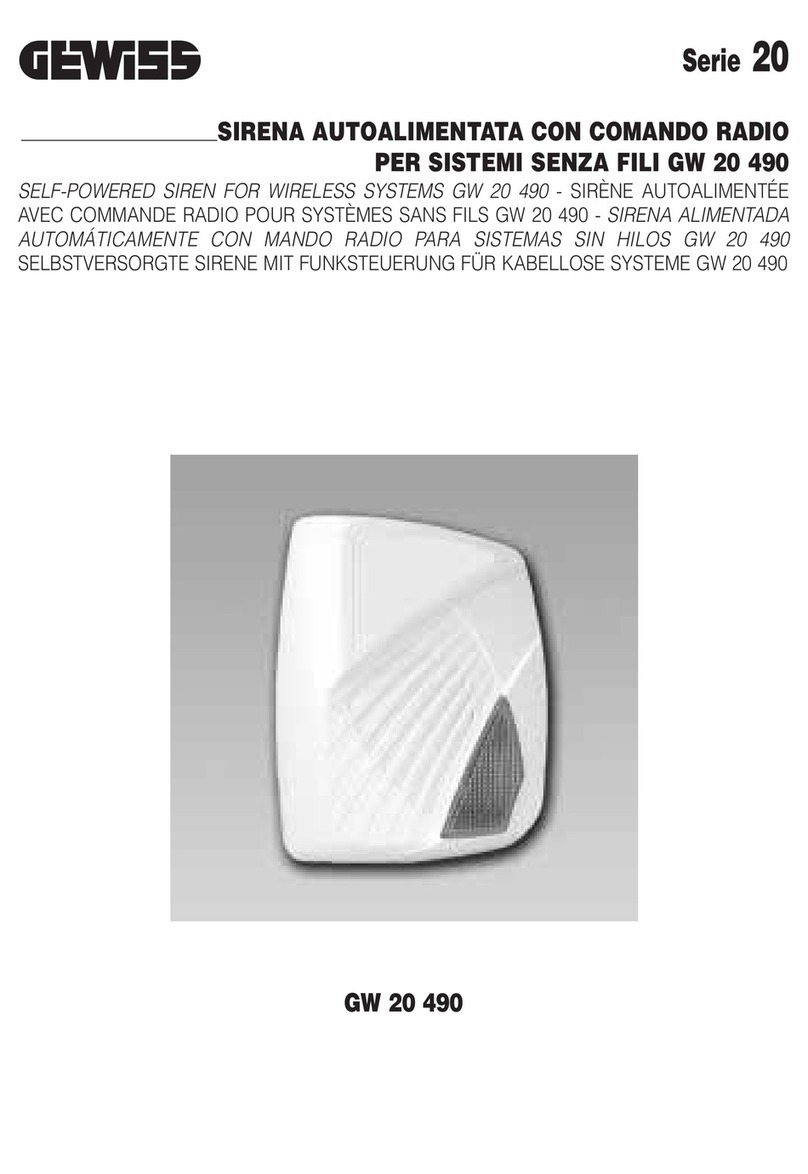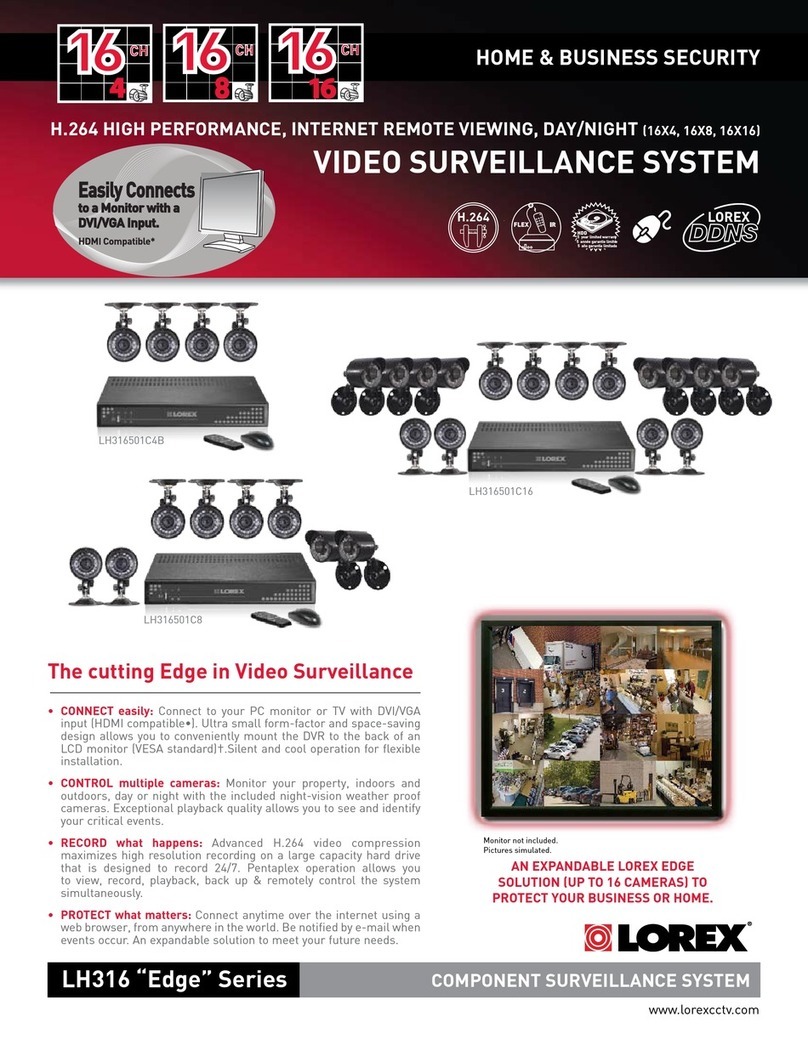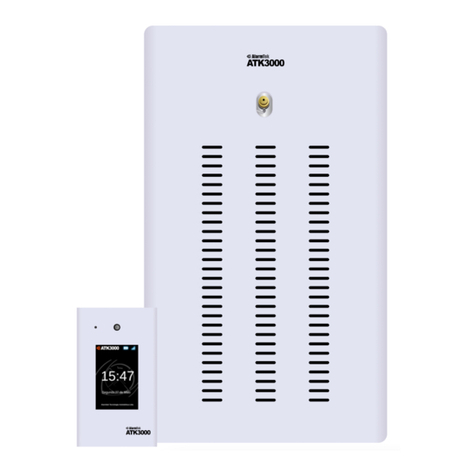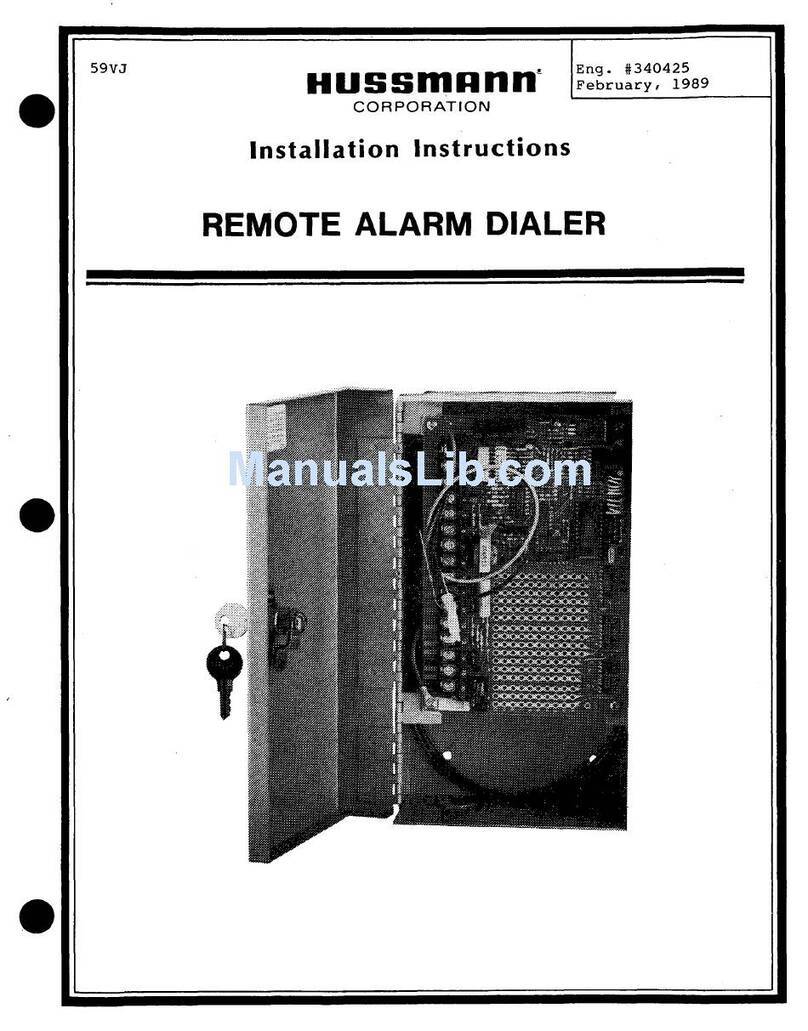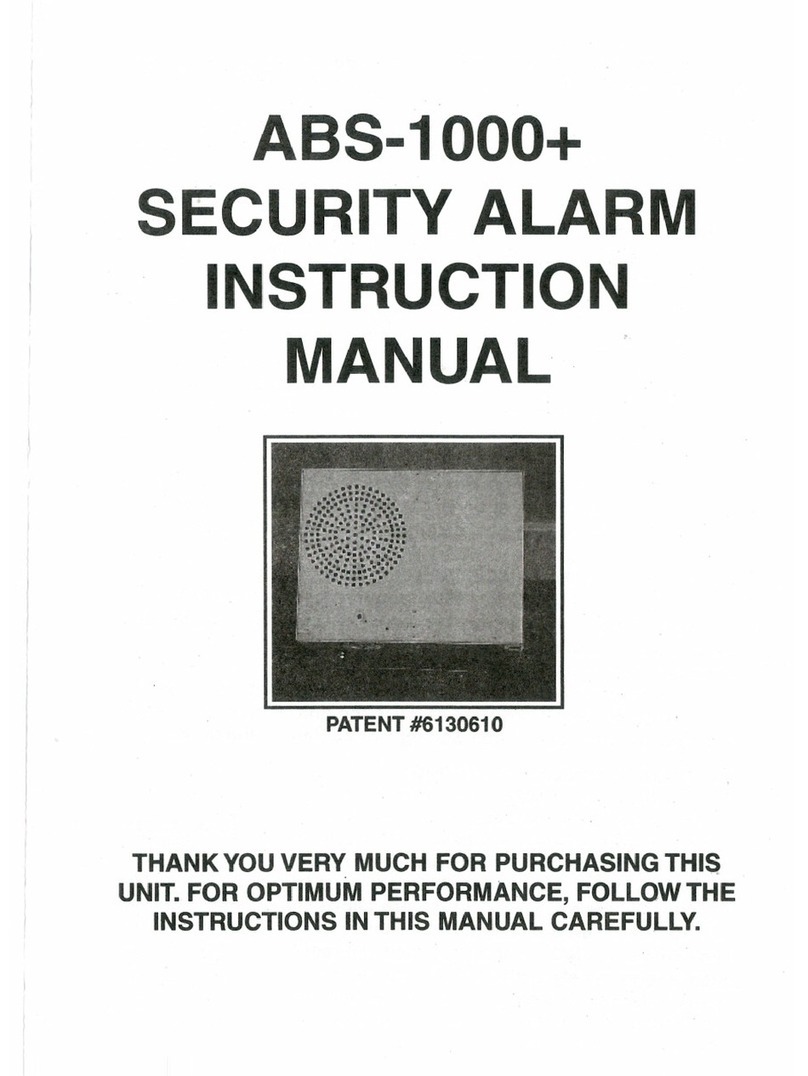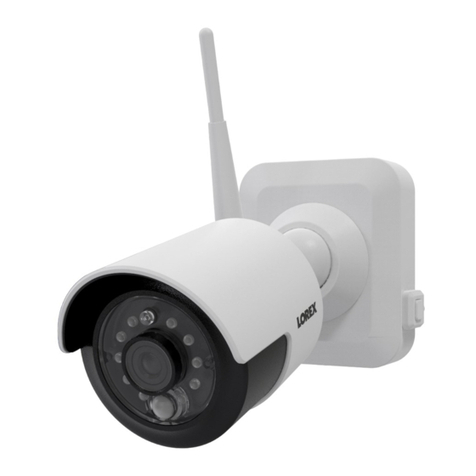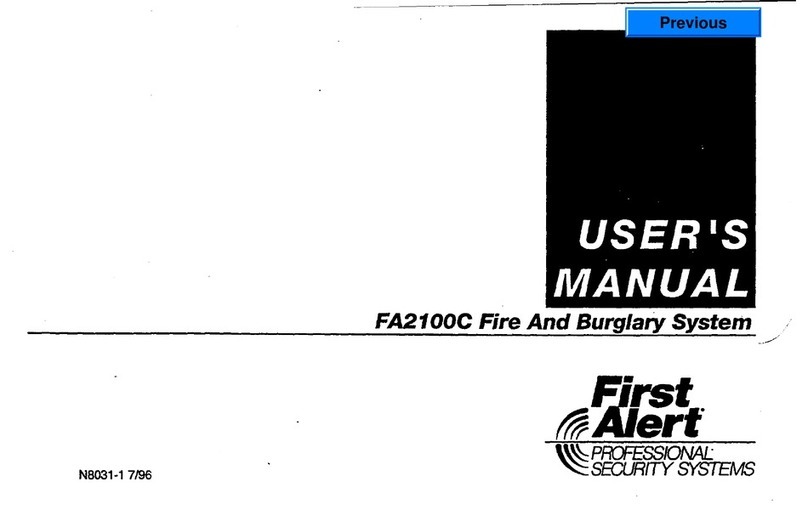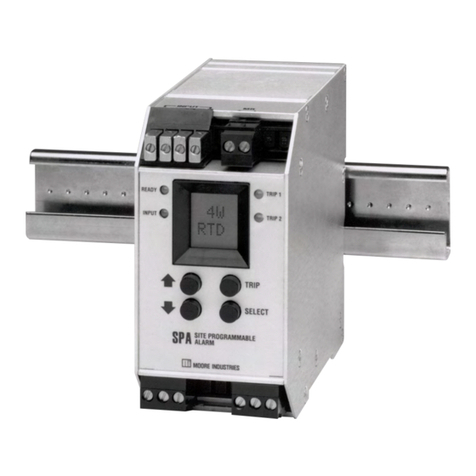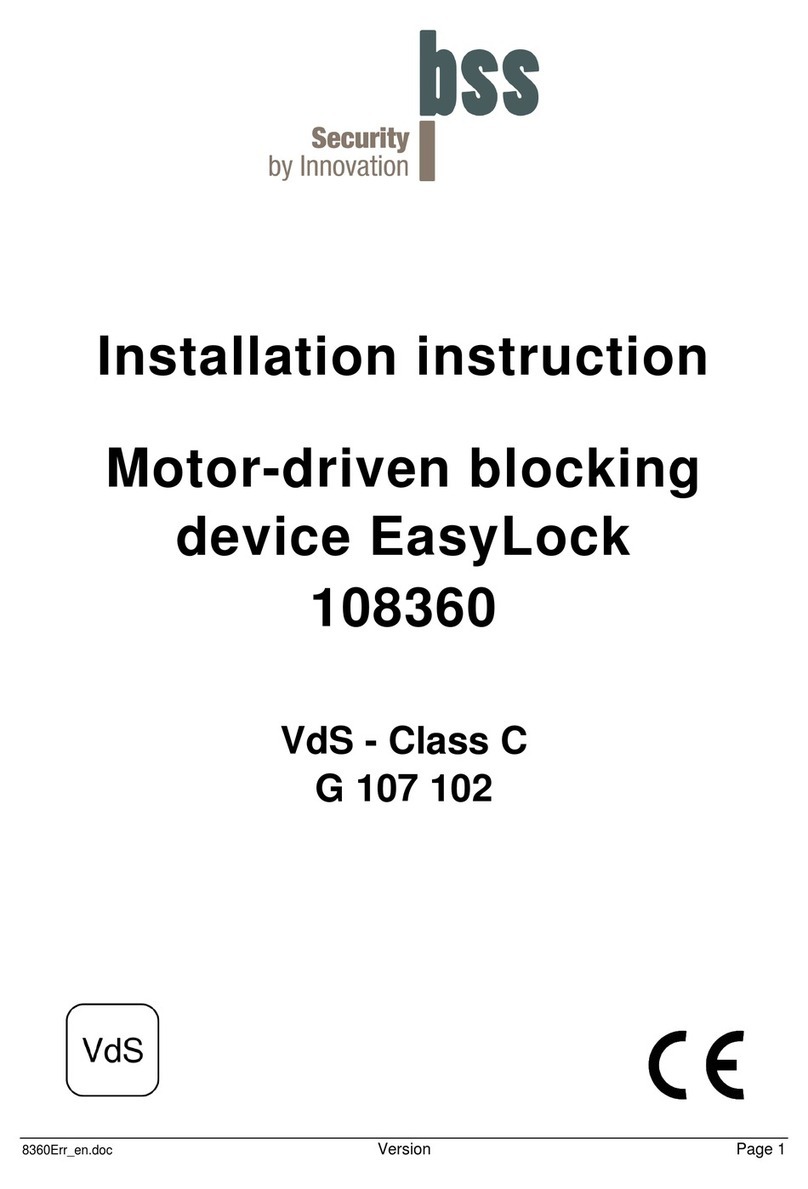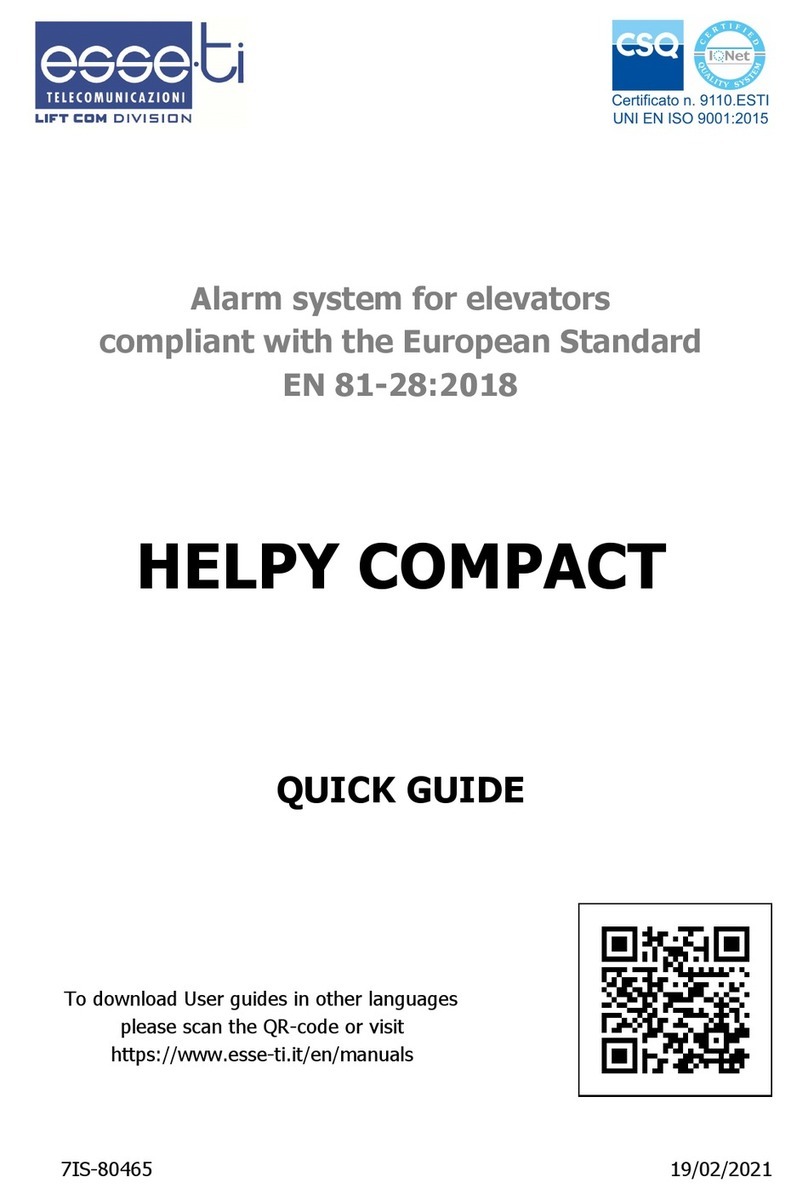Menvier Security TSD402 Installation manual

TSD402
Intruder Alarm
Control Panel & Speech Dialler
Installation & Programming
Instructions
1
4 5 6
7 8 9
HOME 0AWAY
23
UNSET
TSD402

Contents
Regulatory Requirements . . . . . . . . . . . . . . . . . . . . . . . . . . . . . . . . . . . . . 1
General, Application & Approval . . . . . . . . . . . . . . . . . . . . . . . . . . . . . . . . . . . . . . . 1
Connections & Compatibility with PABXs . . . . . . . . . . . . . . . . . . . . . . . . . . . . . . . . . 2
Responsibility for Connection To Telephone Network . . . . . . . . . . . . . . . . . . . . . . . . 2
Ringer Equivalence Number (REN) . . . . . . . . . . . . . . . . . . . . . . . . . . . . . . . . . . . . . . 2
Overview . . . . . . . . . . . . . . . . . . . . . . . . . . . . . . . . . . . . . . . . . . . . . . . . . . 3
Introduction, Features & Control Panel Operation . . . . . . . . . . . . . . . . . . . . . . . . . . 3
Speech Dialler Operation. . . . . . . . . . . . . . . . . . . . . . . . . . . . . . . . . . . . . . . . . . . . . 4
Tone Dialling simulators (Tone Pads) & Specifications. . . . . . . . . . . . . . . . . . . . . . . . 5
System Planning. . . . . . . . . . . . . . . . . . . . . . . . . . . . . . . . . . . . . . . . . . . . . 6
General, Cable Routing, Control Panel & Remote Keypads . . . . . . . . . . . . . . . . . . 6
External Sounder & Detection devices . . . . . . . . . . . . . . . . . . . . . . . . . . . . . . . . . . . 7
Final Exit, Keyswitch & Power Supply Considerations. . . . . . . . . . . . . . . . . . . . . . . . . 8
System Installation . . . . . . . . . . . . . . . . . . . . . . . . . . . . . . . . . . . . . . . . . . . 9
Control Panel layout. . . . . . . . . . . . . . . . . . . . . . . . . . . . . . . . . . . . . . . . . . . . . . . . . 9
Installing the Control Panel . . . . . . . . . . . . . . . . . . . . . . . . . . . . . . . . . . . . . . . . . . . . 9
Mains Connection . . . . . . . . . . . . . . . . . . . . . . . . . . . . . . . . . . . . . . . . . . . . . . . . . 10
Battery Connection . . . . . . . . . . . . . . . . . . . . . . . . . . . . . . . . . . . . . . . . . . . . . . . . 10
Control Panel PCB Layout. . . . . . . . . . . . . . . . . . . . . . . . . . . . . . . . . . . . . . . . . . . . 11
Connections & Controls . . . . . . . . . . . . . . . . . . . . . . . . . . . . . . . . . . . . . . . . . . . . . 11
Connection Diagram . . . . . . . . . . . . . . . . . . . . . . . . . . . . . . . . . . . . . . . . . . . . . . . 15
Installing a TS400 Remote keypad . . . . . . . . . . . . . . . . . . . . . . . . . . . . . . . . . . . . . 16
Wiring the Auxiliary Dialler Inputs . . . . . . . . . . . . . . . . . . . . . . . . . . . . . . . . . . . . . . . 16
Telephone Line Connections . . . . . . . . . . . . . . . . . . . . . . . . . . . . . . . . . . . . . . . . . 17
Pre Power-Up Checks & Initial Power-Up . . . . . . . . . . . . . . . . . . . . . . . . . . . . . . . . . 18
Programming. . . . . . . . . . . . . . . . . . . . . . . . . . . . . . . . . . . . . . . . . . . . . . 20
Programming Menus . . . . . . . . . . . . . . . . . . . . . . . . . . . . . . . . . . . . . . . . . . . . . . . 20
Program Zones . . . . . . . . . . . . . . . . . . . . . . . . . . . . . . . . . . . . . . . . . . . . . . . . . . . . 21
View Event Log . . . . . . . . . . . . . . . . . . . . . . . . . . . . . . . . . . . . . . . . . . . . . . . . . . . . 22
Walk Test. . . . . . . . . . . . . . . . . . . . . . . . . . . . . . . . . . . . . . . . . . . . . . . . . . . . . . . . . 23
Exit Time . . . . . . . . . . . . . . . . . . . . . . . . . . . . . . . . . . . . . . . . . . . . . . . . . . . . . . . . . 23
Entry Time . . . . . . . . . . . . . . . . . . . . . . . . . . . . . . . . . . . . . . . . . . . . . . . . . . . . . . . . 24
Bell Duration Time. . . . . . . . . . . . . . . . . . . . . . . . . . . . . . . . . . . . . . . . . . . . . . . . . . 24
Change Engineer's Passcode . . . . . . . . . . . . . . . . . . . . . . . . . . . . . . . . . . . . . . . . 24
Remote Reset Number . . . . . . . . . . . . . . . . . . . . . . . . . . . . . . . . . . . . . . . . . . . . . 24
System Options. . . . . . . . . . . . . . . . . . . . . . . . . . . . . . . . . . . . . . . . . . . . . . . . . . . . 25
Speech Dialler Alarm Options . . . . . . . . . . . . . . . . . . . . . . . . . . . . . . . . . . . . . . . . 27
Returning to the Unset Mode . . . . . . . . . . . . . . . . . . . . . . . . . . . . . . . . . . . . . . . . . 28
Setting, Part-Setting & Unsetting the System . . . . . . . . . . . . . . . . . . . . . . . . . . . . . . 28
Installation Record. . . . . . . . . . . . . . . . . . . . . . . . . . . . . . . . . . . . . . . . . . 29

Regulatory Requirements
General
The TSD402 control panel must be installed by a electrically competent person. Before
attempting to install the unit, the installer must be aware of the following:
Application
The TSD402 is suitable for connection to the following types of telephone networks:
•Direct exchange lines (PSTN) supporting DTMF (Tone dialling) or Loop Disconnect
(Pulse Dialling).
•PABX exchanges (with or without secondary proceed indication).
+The TSD402 is not suitable for connection as an extension to a pay phone or
1+1 carrier systems.
Approval
The TSD402 is approved for the following usage:
•Automatic call initialisation
•Operation in absence of proceed indication
•Automatic dialling
•Multiple repeat attempts
Usage other than the approved usage or failure to comply with the installation and
programming instructions may invalidate any approval given to the apparatus.
Note the approval Label on back of the control panel:
MENVIERSECURITY
TSD402
POWER REQUIREMENTS 240V AC @ 200mA MAX
REN=0.0
S/1100/3/R/503255
TSD402 Installation Manual Regulatory Requirements
1

Connections
Connection terminals on the TSD402 are described as either "Safety Extra-Low Voltage"
circuits (S.E.L.V) or "Telecommunications Network Voltage" circuits (T.N.V).
The Printed Circuit Board (PCB) layout on page 11 shows the two types of circuits.
+It is important that the installer ensures that T.N.V connections are only
connected to the PSTN and S.E.L.V circuits are only connected to other circuits
designated as S.E.L.V circuits.
+Interconnection circuits should be such that the equipment continues to
comply with the requirements of 4.2 of EN 41003 for T.N.V circuits and 2.3 of EN
60950 for S.E.L.V circuits, after making connections between circuits.
Compatibility with PABXs
The TSD402 is only approved for use with compatible PABX systems. Correct operation in
all circumstances is not guaranteed. If you experience any difficulties contact Menvier
Technical Support.
Responsibility for Connection To Telephone Network
The person responsible for connection of the TSD402 to a PABX system is as follows:
1If the wiring is owned by British Telecom PLC
a) British Telecom
2If the wiring is not owned by British Telecom, either:
a) British Telecom
b) The authorised maintainer
c) A professional installer after 14 days written notice to the authorised maintainer.
Ringer Equivalence Number (REN)
The Ringer Equivalence Number for the TSD402 is 0.0 and as such any number can be
simultaneously connected to an exclusive line.
Regulatory Requirements TSD402 Installation Manual
2

Overview
Introduction
The TSD402 is a 5 zone (+ Final Exit) control panel with an integral Speech Dialler. It is ideally
suited for domestic and small commercial installations, which require additional security
through the communication of audio alarm messages over the telephone line.
Features
•5 Programmable zones Night, Access, Fire, PA & Keyswitch (plus common tamper)
•Final Exit zone
•Detector Reset output for Vibration and Smoke detectors
•Internal and external volume controls
•16 character Liquid Crystal Display (LCD)
•2 user passcodes and engineers passcode
•64 event log
•Programmable Chime facility on all zones
•Remote Reset facility
•3 button Quick-Set for Home and Away
•Program data stored in NVM (recorded messages are not)
•Remote Keypad option (up to 4 x TS400 Remote Keypads)
•Auxiliary trigger inputs for the speech dialler
•Speech dialler activations may report to different telephone numbers
•Built in microphone and speaker for record and play-back
•Messages may be up to a total of 60 seconds in length
Control Panel Operation
Operation and programming is carried out from the tactile rubber keypad on the control
panel in conjunction with the 16 character LCD display.
There are two programming menus within the system. The engineer's programming menu
allows full system programming (zone types, view log, walk test, exit time, entry time, bell
duration time, engineers code, reset number, system options). The user programming
menu allows setting and unsetting of the system as well as allowing the user to test the
system. All speech dialler programming, configuration and testing is also carried out within
the "User Options" menu (for full details on speech dialler programming see User Manual).
TSD402 Installation Manual Overview
3

The TSD402 incorporates a 3 button set facility which simplifies the setting and part-setting
of the system for user. When the user wishes to full set the system, they simply enter the first
2 digits of their passcode followed by the AWAY key. To part-set the system, they simply
enter the first 2 digits of their passcode followed by the HOME key. When unsetting the
system the user must enter all 4 digits of the passcode.
Speech Dialler Operation
The speech dialler may be configured by the engineer to trigger on FIRE, P.A. or ALARM
activations for both the Away set and Home set. In addition to alarm triggers provided
internally from the control panel, there are 3 auxiliary inputs which may be used by other
devices to trigger the speech dialler independently from that of the control panel.
Telephone
Numbers -The TSD402 stores up to three different telephone numbers. Each
number may be up to 16 digits long and are simply
programmed using the text display and keypad on the unit. The
unit is compatible with most PABX systems that require a pause
or wait for secondary dial tone. Note: The Emergency Service
numbers (999 &112) cannot be programmed into the unit.
Messages -The TSD402 has a built-in microphone and speaker so that
phrases can be recorded and replayed directly from the unit. A
message is formed by combining a common phrase (0) and
one of the alarm phrases (F, P or A). When the out-going call is
answered the unit plays the common phrase (0) and one of the
three alarm phrases F, P or A. Phrase 0 states the name and
address of the user and phrases F, P and A relate to the alarm
type (FIRE ,PA, ALARM). There is 60 seconds of recording time
available for phrases and each phrase can be any length as
long as the total does not exceed 60 seconds. For example, the
"Common Phrase" may be 12 seconds, "Phrase F" 5 seconds,
"Phrase P" 8 seconds and "Phrase A" 7 seconds.
Reporting Options -Each alarm type (F, P or A) may be programmed to report only
to selected telephone numbers. For example the Fire activation
may be programmed to report to all three telephone numbers,
whereas the Alarm activation may be programmed to report
only to telephone numbers 1 and 3 etc.
Call
Acknowledgement -When the call is answered, the message is played. At the end of
the message the unit sends an audible "bleep" which must be
answered within 2 seconds using the tone generated by pressing
the number [8] button on a standard telephone. On hearing the
[8] tone the unit immediately sends a second "bleep" which must
be answered in the same way. If successful, a multi-tone
confirmation signal is then heard, if not then the message is
Overview TSD402 Installation Manual
4

repeated with the acknowledgement "bleeps" again. If the call
is not acknowledged at the end of the fifth play of the message
the unit abandons that call and attempts the next telephone
number. This procedure is repeated three times in sequence for
all three telephone numbers. If no acknowledgement has been
received then the speech dialler shuts down.
Acknowledgement
Options -The TSD402 may be programmed to stop dialling after the first
call has been acknowledged or when two, or three have been
acknowledged. The acknowledgement may also be disabled
altogether, when the speech dialler is used in this mode it dials
the first telephone number and providing the call is answered it
plays the message and shuts down. If the call is not answered it
dials the next telephone number etc.
Aborting a Call -If the system is accidentally triggered the speech dialler is
automatically shut down when a valid user passcode is entered.
Tone Dialling simulators (Tone Pads)
For the acknowledgement procedure to work successfully the TSD402 "looks" for a 1 second
of tone between 600Hz and 1400Hz. This is supplied most reliably by the [8] button used
for MF dialling although other buttons may work if pressed accidentally.
If the recipients telephone cannot produce a suitable tone then a "Tone Dialling Simulator"
(Tone Pad) may be required. These are available from many high street electrical stores
and also from specialist suppliers such as RS Components (stock code 252-841) and
Maplin Electronics (stock code CK25C).
Specifications
Panel Input Voltage: 240V +/- 10% 50Hz
Current Consumption: 80 mA
Auxiliary power: 13.8v @ 300 mA
Remote Keypad: TS400REM (normal 20mA, alarm 32mA)
Trigger inputs (speech dialler): +ve or -ve applied, input voltages 5 - 28V
REN Value: 0
BT Approval number: S/1100/3/R/503255
Control Panel Dimensions: 205 (W) x 205 (H) x 64 (D) mm
Remote Keypad Dimensions: 130 (W) x 130 (H) x 30 (D) mm
Control Panel Weight: 1.4 Kg
Battery Size 2.1Ah
Case Construction: 3mm Polycarbonate
Environment: 0 - 55°C
TSD402 Installation Manual Overview
5

System Planning
General
The TSD402 is a flexible system, but care must be taken in planning the installation to
provide maximum protection with minimum installation effort.
Survey the household and determine where each security device is to be fitted. Wherever
possible, try to conceal wiring (e.g., in the loft, under carpets or floorboards and inside
cupboards). Commit the system design to paper for easy reference.
Cable Routing
When installing cables, the following should be noted:
•Ensure that all cables are kept clear of mains supply cables, telephone cables,
cables supplying bells or sounders and any cables likely to induce electrical noise
(R.F.)into the system.
•Screened cable may prove necessary if cables are run adjacent to cables which
carry R.F. (electrical noise) or are switching high current loads.
•The mains power supply cable to the system must be connected to an
un-switched fused spur that cannot be accidentally switched off. The mains cable
must enter the housing via its own cable entry point.
Control Panel
The control panel should be sited in a position where it has easy access for the users to
set and unset the system. It should also be mounted in a well lit area and at a level where
it is easy to read the Liquid Crystal Display (LCD). The provision for connecting to a
permanent mains supply must also be considered.
The control panel is supplied with a 2 metre telephone lead which plugs directly into any
standard B.T. telephone socket, it is therefore recommended that the unit is also sited as
near to a B.T. telephone socket as possible. If this it not possible an approved B.T. extension
lead may be required or the unit can be hard wired to the B.T. socket (see Installation).
When operating the system it should be possible to hear the exit and entry tones throughout
the exit/entry route and outside the final exit door. If the control panel is sited along way
from the final exit door it may be necessary to fit an extension loudspeaker.
Remote Keypads
If required, up to four remote keypads may be connected to the system to allow remote
setting and unsetting of the system. The remote keypad uses LED indicators to show zone
faults and alarms, and has an internal sounder to indicate exit and entry tones. Remote
keypads require a six-core cable for connection.
System Planning TSD402 Installation Manual
6

External Sounder
The External Sounder should be mounted as high as possible so that it is visible and out of
reach to potential intruders. A six core cable is required for connection to the sounder, it
should enter directly through the wall and into the sounder via the cable entries in the back
plate. However, if the cable is run over the surface to the sounder then it should be
protected (e.g., the cable may be run in aluminium conduit).
Detection devices
There are several types of detection devices available which are suitable for domestic
installations as follows:
Passive Infra-Red
(PIR) -A movement detector which detects movement of an intruder
by the change in infra-red body heat. When fitting PIRs, refer to
the installation instructions supplied with the unit.
In general there are two types of PIR "Standard" and "Latching".
Normally the standard type is used where one detector per zone
is fitted. A six core cable is required for connection.
The latching type is used when more than one detector is fitted
to a zone, the latch facility allows the user to identify the triggered
detector by means of the indicator LED on the detector "latching"
on. If latching detectors are used an eight core cable is required
for connection.
Magnetic
Contacts -Magnetic contacts consist of an electrical switch which is
operated by a magnet. They come in two varieties, the "Flush"
type is designed to be fitted into the top or side of the
door/window. The "Surface" type is designed to fitted to
doors/windows where it is not possible to use flush contacts e.g.
garage doors, UPVC windows etc. Both types of contacts require
a four core cable for connections.
Personal Attack
(PA) Button -Normally PA buttons are located by the front door or adjacent to
the bed, and preferably out of reach to small children. Pressing the
button at any time will generate a full alarm. After pressing the
button, it must be reset with the key provided and then reset at the
control panel. PA buttons require a four core cable for connections.
Vibration Detectors -Vibration detectors are normally fitted to windows or door frames.
They are triggered when the device senses a shock attack.
Vibration detectors require a six core cable for connections.
Smoke/Heat
Detectors -12V Smoke or heat detectors may be connected to the system
to provide additional protection against fire. When activated a
distinctive internal sounder tone is generated and the external
sounder is pulsed. Smoke detectors require a four core cable for
connections.
TSD402 Installation Manual System Planning
7

Final Exit
This is the point at which the user leaves and enters the premises (normally the front door).
When setting the system the user must leave the premises via the exit route and through
the Final Exit zone. When re-entering the premises the user must activate the Final Exit zone
to start the entry timer which allows the user time to gain access to the control panel to
unset the system. If the user enters the premises through any other point and triggers a
detection device a full alarm will be generated.
The system may be programmed to set after the exit timer has expired or by the operation
of the Final Exit detection device.
Keyswitch
An optional keyswitch may be fitted to the system to allow the user to set and unset (or
part-set and unset) the system using a physical key rather than a four digit passcode.
Power Supply Considerations
The maximum current available from the control panel power supply is 750mA. The total
current consumption of all devices (Panel, detectors, sounders, strobes battery charge
etc.) that are connected to the system must not exceed 750mA.
The following is a typical example on how the total current is calculated. When calculating
the total current for your own installation refer to the manufacturers specifications on each
device.
Total available current from control panel = 750mA
Control panel = 80mA
+
External Sounder = 250mA
+
External Strobe = 120mA
Total Current = 450mA
Auxiliary Current = 300mA (750 -450)
From the above calculation example there is 300mA available for powering detection
devices etc.
System Planning TSD402 Installation Manual
8

System Installation
Control Panel layout
Installing the Control Panel
+For your safety, installation of the TSD402 must be conducted in the following
sequence.
1Remove the screw from the top of the control panel and lift away the front cover.
2Ensure that there is no battery in the housing, then remove the PCB as follows:
a) Disconnect the AC leads from the transformer and unplug the internal
loudspeaker from the Printed Circuit Board (PCB).
+-
Loudspeaker
(Under PCB)
PCB
PCB
Clips
Battery
2.1 Ah
max.
PCB
Supports
Mains Cable
Entry
Fused
Terminal
Block
(200mA)
Transformer
Cover
Clips
Holders for
spare fuses
Cable Entry
Figure 1 TSD402 Control Panel layout
TSD402 Installation Manual System Installation
9

b) Pull down the plastic clip at the bottom right hand corner of the PCB and gently
lift the PCB forward.
c) Repeat with the plastic clip at the bottom left hand corner of the PCB.
d) The bottom of the PCB will then swing forward and the whole PCB will come away
from the base.
3Hold the base in the required position and mark the centre of the keyhole positions.
Remove the base, then drill and plug the holes. Note: Remember to allow enough
room to get the cover screw in to top of panel when mounting the base.
4Re-position the base and secure to the wall with 3 x No. 10 11⁄4" wood screws.
5If a remote keypad is being fitted to the system, refer to page 16.
6Re-fit the PCB assembly by aligning the top of the PCB into the 2 supports in the top
of the housing ensuring that the edges of the board sit between the 2 flanges, then
push the bottom of the PCB until it clicks in place.
7Re-connect the AC leads to the transformer.
8Connect the mains to the fused terminal block in the panel via an un-switched fused
spur, ensuring that the cables enters the housing via its own cable entry point.
Mains Connection
The mains supply is connected to a 3 way "Euro Type" fused terminal block. To comply
with BS4737 the supply should be fed from an un-switched fused spur fitted with a 3A fuse.
All electrical connections should be carried out by a technically competent person and
must comply with the current IEE regulations.
Battery Connection
A 2.1Ah battery must be fitted to the control panel to allow the system to function during
a mains fail condition.
The TSD402 is equipped with a "Battery Protection" circuit so that if a battery is accidentally
reverse connected or its voltage is below 8V, the "Battery Fault" LED illuminates. To clear
the fault simply reconnect or replace the battery as appropriate.
System Installation TSD402 Installation Manual
10

Control Panel PCB Layout
Connections & Controls
The main PCB has the following "Jumper Plugs" (JP), indicator LEDS and terminal
connections:
TRIG POLARITY (JP1) -This jumper-link sets the signal polarity for the auxiliary speech
dialler trigger inputs. The inputs may be either +ve applied to
trigger or -ve applied to trigger.
SPEAKER (JP2) -The internal loudspeaker has a 2-way connector which plugs
directly on to this set of pins.
FACTORY RESET
(JP3) -All program data (Not messages) is stored in a Non-Volatile
Memory chip (NVM). If the Factory Reset pins are shorted during
power-up all stored system parameters are over written with the
factory default settings. The engineer passcode is reset to 1234
and the User 1 passcode is set to 5678.
TRIG
POLARITY
F
ACT
OR
Y
REST
AR
T
VR1
EXT. VOLUME TRIGGER
A
P
F
INT. VOLUME
SPEAKER
A
B
BC
A.C.
ALM
-
RST
-
TRG
-
STB
-
+ H/O -
TMP
-
AUX
T
AMPER
L/S
-
AUX 12V
+ -
P
.A.
ZONE 5
FIRE
ZONE 4
K'SW
ZONE 3
ACCESS
ZONE 2
ACCESS
ZONE 1
F/EXIT
AuxiliaryDialler
TriggerInputs
(S.E.L.V Circuit)
RemoteKeypad
Interfacesocket
(S.E.L.VCircuit)
Microphone
TactileRubber Keypad
TelephoneLine
ConnectionTerminals
(T.N.V Circuit)
Internal VolumeControl
Connectionto
Internal Speaker
ExtensionSpeaker Volume ControlAuxiliaryTriggerInput
Polarity Selector
Factory Restart Pins
BellFuse(1 Amp)
Aux 12V Fuse
(1Amp)
FlyingLeads
to T ransformer
Tamper Switch
Zone
Connections
(S.E.L.V Circuit)
123
456
789
HOME 0AWAY
JP2
-
+
JP1
JP3
VR2
EXTERNAL BELL
16 Character LCD Display
Figure 2 TSD402 PCB Layout
TSD402 Installation Manual System Installation
11

Connections & Controls (Cont.)
EXT. VOLUME (VR1) -If an extension loudspeaker is connected to the control panel,
the volume of keypad bleeps, chime, entry and exit tones may
be adjusted using this control (clockwise to increase). Alarm
tones are always full volume.
INT. VOLUME (VR2) -This controls the volume of keypad bleeps, chime, entry and exit
tones from the internal loudspeaker (clockwise to increase). The
volume of the speech dialler playback messages are always full
volume.
F/EXIT -This pair of terminals is for connecting to the Final Exit detection
device, normally a set of magnetic contacts on the front door.
The tamper loop should be connected in series with other loops
across the terminals mark AUX TAMPER (see Connection
diagram).
ZONE 1 (Access) -This pair of terminals may be connected to any type of normally
closed detection device. When activated during a set condition,
a full alarm is generated. It is also possible to program the zone
as "Access" this allows the detector to be activated during entry
and exit when setting/unsetting the system. If the zone is
programmed as "Access" and is armed during a part-set (Home)
condition it will start the entry timer if activated. The tamper loop
should be connected in series with other loops across the
terminals mark AUX TAMPER (see Connection Diagram).
ZONE 2 (Access) -As Zone 1.
ZONE 3 (K'SWITCH) -This pair of terminals may be connected to any type of normally
closed detection device. When activated during a set condition,
a full alarm is generated. It is also possible to program the zone
as "Keyswitch" this allows the zone to be connected to an
electrical keyswitch to set and unset the system. The keyswitch
functionality maybe further programmed to either full set (Away)
or part-set (Home) the system. (see Programming). The tamper
loop should be connected in series with other loops across the
terminals mark AUX TAMPER (see Connection Diagram).
ZONE 4 (Fire) -This pair of terminals may be connected to any type of normally
closed detection device. When activated during a set condition,
a full alarm is generated. It is also possible to program the zone
as "Fire" this allows the zone to be connected to any type of
normally closed smoke or heat detector. The tamper loop should
be connected in series with other loops across the terminals mark
AUX TAMPER (see Connection Diagram).
System Installation TSD402 Installation Manual
12

ZONE 5 (PA) -This pair of terminals may be connected to any type of normally
closed detection device. When activated during a set condition,
a full alarm is generated. It is also possible to program the zone
as "PA" this allows the zone to be connected to any type of
normally closed PA buttons. The tamper loop should be
connected in series with other loops across the terminals marked
AUX TAMPER (see Connection Diagram).
AUX 12V +/- -The auxiliary 12V terminals provides permanent 12V @ 300mA
of power for detectors which require a low voltage supply e.g.,
PIR's, Vibration Detectors, Smoke Detectors etc. The output is
protected by a 1 amp fuse (Aux 12V).
L/S - -A 16Ωextension loudspeaker may be connected between L/S-
and AUX 12V+ terminals. The loudspeakers will reproduce all
alarm and advisory tones generated by the control panel.
+If an extension loudspeaker is fitted to the system it
must be sited more than 0.5 metres from the control
panel. The play-back of speech dialler messages are
not reproduced at the extension loudspeaker.
AUX TAMPER -The tamper protection for all devices must be connected in
series then connected to this pair of terminals.
TMP- -This terminal provides the tamper protection to the external
sounder. It should be connected to the negative tamper return
output on the external sounder. If the external sounder is not
required to be tamper protected, this terminal must be linked to
H/O -.
H/O -/+ -The "Hold Off -" and "Hold Off +" terminals provide permanent
12V hold off supply for the external sounder or SAB module. The
output is protected by a 1 amp fuse (Bell Fuse).
STB - -This terminal provides the switched negative strobe trigger output
(max. 500mA). It should be connected to the -ve strobe input on
the external sounder or SAB module.
The strobe output is activated on all types of alarm (Fire, PA and
Alarm), the output will only deactivate when the triggered alarm
is fully reset.
If a zone remains in a fault condition when the system attempts
to set, the strobe output is activated to give the user external
indication that the system has failed to set.
TSD402 Installation Manual System Installation
13

Connections & Controls (Cont.)
TRG - -This terminal provides the switched negative bell trigger output
(max. 500mA). It should be connected to the -ve bell trigger
input on the external sounder or SAB module. The output may be
programmed for SAB or SCB operation:
SAB
When programmed as SAB, the output will switch to 0V on alarm.
SCB
When programmed as SCB, the output provides a 0V hold off,
which is removed on alarm.
RST - -This terminal may be programmed as either:
Detector Reset
This type of output is used to power detectors which latch their
alarm condition (e.g., smoke detectors, vibration detectors
etc.). Power for such detectors must be connected between
AUX 12V+ and RST-. Following a full alarm the power to this
output is momentarily removed when the user/engineer has
reset the system, this will allow the such detectors to "Reset".
Switched 12V
When programmed as "Switched 12V" the output may be
connected to the latch input terminal on latching detectors
(e.g., PIRs etc.). This feature is normally used when more than
one detector is connected to a single zone. It allows the user to
identify the alarm source by latching the indicator LED on the
detector that caused the alarm activation. The latched LED will
clear when the system is reset.
ALM - -This terminal is switched negative (100mA) on alarm and is
removed when the system is reset.
TRIGGER F,P & A -These terminals are the auxiliary Fire, PA and Alarm trigger inputs
for the speech dialler, they may be used to trigger the the unit
independently from that of the control panel. For example, a
smoke detector could be directly connected to input "F", when
activated it would trigger the "Fire" message on the speech
dialler but not cause the control panel to alarm.
A, B & BC -These terminals are for the telephone line connections, they must
be connected to an approved "B.T. Master socket" or "Extension
socket" using the lead provided (see BT Connections).
System Installation TSD402 Installation Manual
14

Connection Diagram
ALM-
RST-
TRG-
STB-
+
-
TMP-
AUX
TAMPER
L/S-
+
-
ZONE5(PA)
H/O
AUX12V
ZONE4(Fire)
ZONE3(K/Sw)
ZONE2(Access)
ZONE1(Access)
FINALEXIT
TSD402
PIR
+12V
0V
TAMPER
ALARM ToZone1
ToAUX12V-
ToAUX12V+
PIR
+12V
0V
TAMPER
ALARM ToZone2
ToAUX12V-
ToAUX12V+
ToZone3
ToFINALEXIT
ToZone5(P .A.)
P.A.Button
FlushContact
SurfaceContact
TerminalStrip
(Notsupplied)
ALARM
Supply -
Supply+ ToAUX+12V
ToRST-
ToZONE4
SmokeDetector
TRIGGER-
STROBE-
HOLDOFF+
HOLDOFF-
TAMPERRETURN-
ExternalSounder
=
Note
Any unused Zones must be
linked out.
PIRs and Surface Contacts may
be connected to any zone. This
diagram is only used to
represent a typical installation
example.
If a Keyswitch is fitted, it must
be connected to Zone 3 and
then programmed as
KEYSWITCH.
If a Smoke/Heat Detector is
fitted, it must be connected to
Zone 4 and then programmed
as FIRE.
If a P.A. Button is fitted, it must
be connected to Zone 5 and
then programmed as P.A.
16 Ohm Extension Loud speaker
(cut R37 to reduce volume)
Figure 3 Sample Connection Diagram
TSD402 Installation Manual System Installation
15

Installing a TS400 Remote keypad
Up to four TS400 remote keypads may be connected to the TSD402 control panel. The
remote keypad is supplied with an interface PCB which plugs onto the main PCB. Remote
keypad(s) may be sited up to a maximum of 50 metres from the control panel using a
six-core cable for connections.
+The TS400 remote keypad is only suitable for setting, part-setting, unsetting and
limited programming functions. All other system operations must be carried out
at the control panel.
1Remove the TSD402 PCB from the case (see page 9 for full details)
2Connect each core of the six-core cable to the interface terminals "LEDCBA" (make
a note of the colours used for each connection).
3Pass the yellow flying-lead behind the PCB and connect it to the L/S-terminal.
4Plug the interface PCB onto the TSD402 PCB (see figure 2 on page 11).
5Replace the TSD402 PCB.
6Separate the remote keypad cover and base by using a screwdriver to push two of
the clips (top or bottom) inwards from the cover retaining slots. Then lift the cover
assembly away, noting that the PCB is connected to the under side of the cover.
7Hold the remote keypad base in position (keyhole to the top) and mark the three
securing holes, drill and plug the wall as required. Pass the six-core cable into the
base via the cable entry points as appropriate and secure the base to the wall.
8Connect each core of the six-core cable to the remote keypad terminals "EDCBAL",
ensuring that the connections through to the control panel are A-A, B-B, C-C etc. If
more remote keypads are to be fitted, they may be connected in a "Star" or
"Daisy-chain" configuration (providing the cable length to the last or furthest remote
keypad does not exceed 50 meters).
9Carefully reattach the front cover assembly to the remote keypad base ensuring that
all cables are clear of the tamper switch spring and the cover is securely clipped to
the base.
Wiring the Auxiliary Dialler Inputs
The auxiliary speech dialler inputs may be connected to devices that are required to signal
the speech dialler independently from the control panel. The inputs may be selected for
various types of signalling as shown in Figure 4.
System Installation TSD402 Installation Manual
16

Telephone Line Connections
There are two methods of connection for the TSD402 to the telephone line. The first is to
use the 2 metre lead supplied (recommended method of connection) which will directly
plug into any standard British Telecom telephone socket. The second is to directly connect
the unit to an NTE5 Master Socket (Line Box). Figure 5 shows both methods of connection.
TRIGGER
A
P
F
+
-
AUX 12V
+-
TRIG POLARITY
12V on alarm
N.O.
Loop
N.C.
Loop 1KW
resistor
TSD402
Alarm input = Normally Closed
PA input = NormallyOpen
Fireinput =Switched +ve
TRIGGER
A
P
F
+
-
AUX 12V
+-
TRIG POLARITY
0Von alarm
N.C.
Loop
N.O.
Loop 1KW
resistor
TSD402
Alarm input = Normally Open
PA input = NormallyClosed
Fireinput =Switched -ve
Figure 4 Signalling Types for Auxiliary Dialler Inputs
A
B
BC
A
B
BC
White
Red
Blue
Standard BT telephone plug
TSD402
TSD402
Connectionusingthe lead supplied
Direct method of connection
3
2
1
6
5
4
Orange/Whitering
White/Bluering
Blue/Whitering
BT Master Jack (NTE5)
Useraccessibleconnections Cable type 1/0.5mmCW1308
Figure 5 The Two Methods of BT Line Connections
TSD402 Installation Manual System Installation
17

Pre Power-Up Checks
Before applying any power to the system, give the system one final check to ensure that:
1The telephone lead is unplugged from the telephone socket.
2The wiring and connections conforms to the requirements detailed in this manual.
3All system cables are kept clear of mains supply cables, telephone cables and R.F.
cables. It is recommended that cable ties be used to keep cables separated.
4Calculate the total system power consumption and ensure that it does not exceed 750mA.
5Mains supply cables to the system are connected to an un-switched fused spur.
Initial Power-Up
1Place a small screwdriver blade between the pins on the Control Panel PCB, marked
FACTORY RESTART (located top left corner). This will ensure that the factory default
values are loaded into memory as show below:
Engineer's Passcode -1 2 3 4
User 1 Passcode -5 6 7 8
User 2 Passcode -Not programmed
Zone 1 -Night
Zone 2 -Access
Zone 3 -Night
Zone 4 -Night
Zone 5 -Night
Final Exit -Exit
Exit Time -030 Seconds
Entry Time -030 Seconds
Bell Duration -020 Minutes
Remote Reset Number -004
Bell Output -SAB (-ve Applied)
Setting Mode -Timed Exit
Reset Authority -User Reset
Number of Re-arms -3
Operation of Key Switch -AWAY Set (Full)
Operation of RST- Output -Switched 12V
Operation of Final Exit in P/Set -Final Exit
HOME Setting -Zone 1 Omitted
Dialler Alarm Options -No Alarms Report
Acknowledgement Option -Cleared by any 1
System Installation TSD402 Installation Manual
18
Other manuals for TSD402
2
Table of contents
Other Menvier Security Security System manuals

Menvier Security
Menvier Security SD1 Installation guide

Menvier Security
Menvier Security TS2500 Assembly instructions
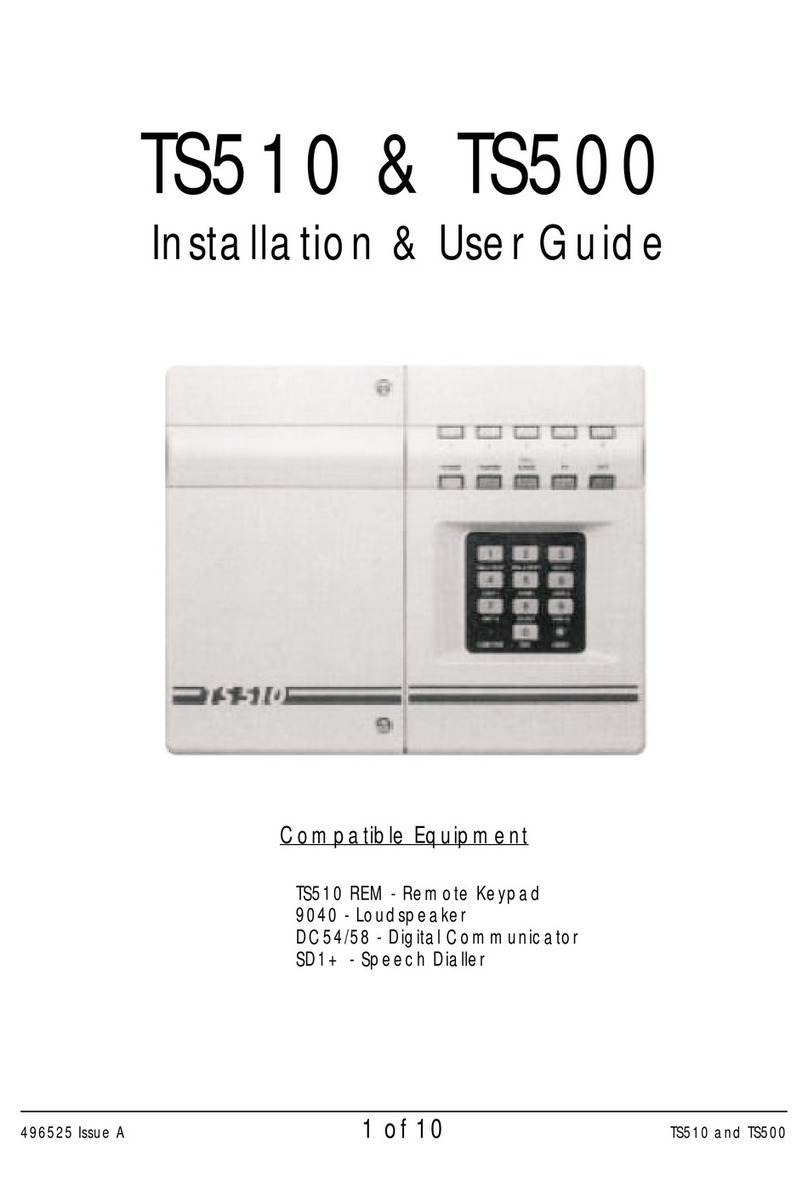
Menvier Security
Menvier Security TS510 Operation manual
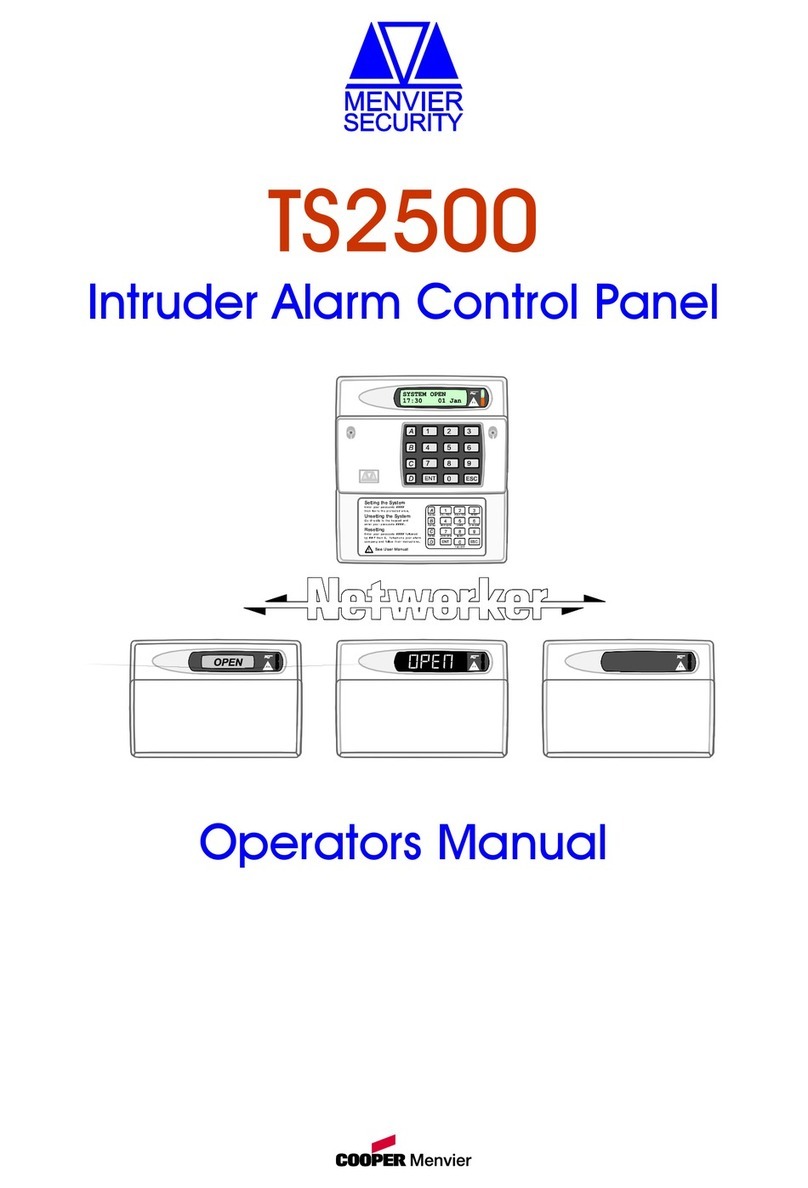
Menvier Security
Menvier Security TS2500 User manual
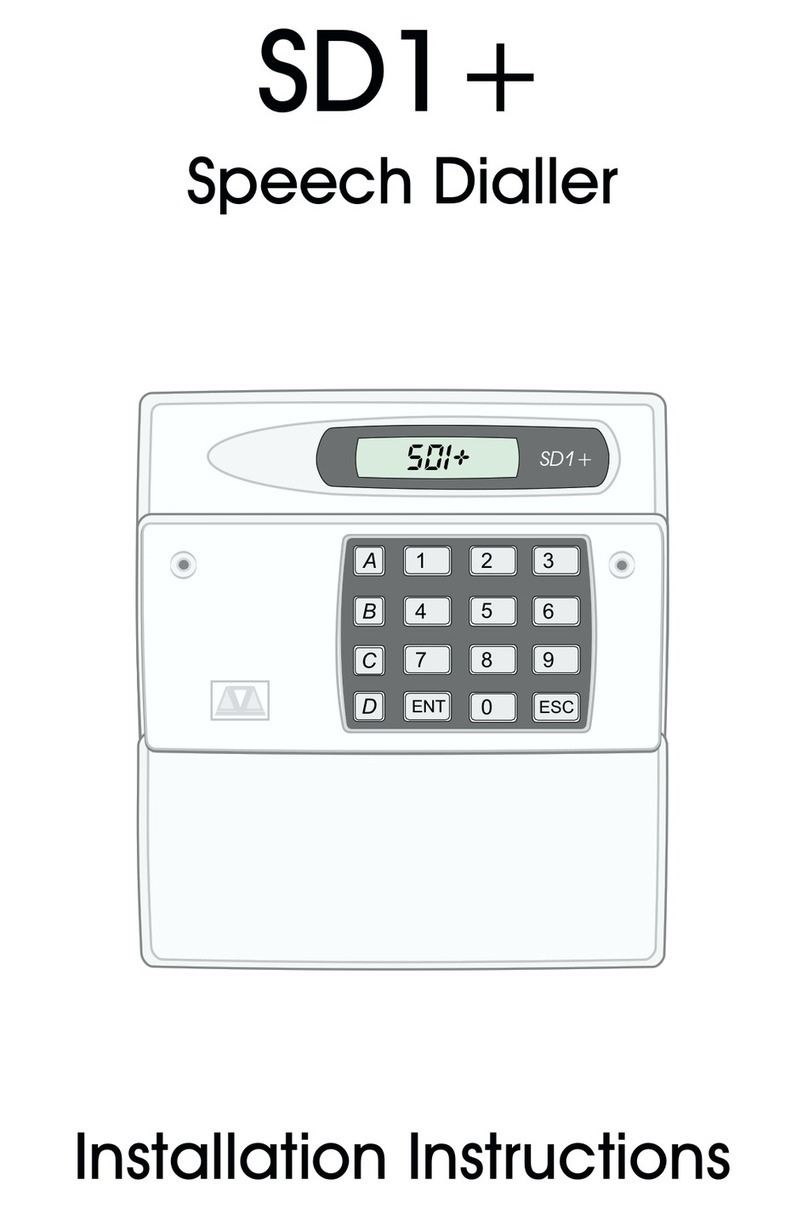
Menvier Security
Menvier Security SD1 User manual

Menvier Security
Menvier Security SD1 Manual

Menvier Security
Menvier Security TS400 Operation manual
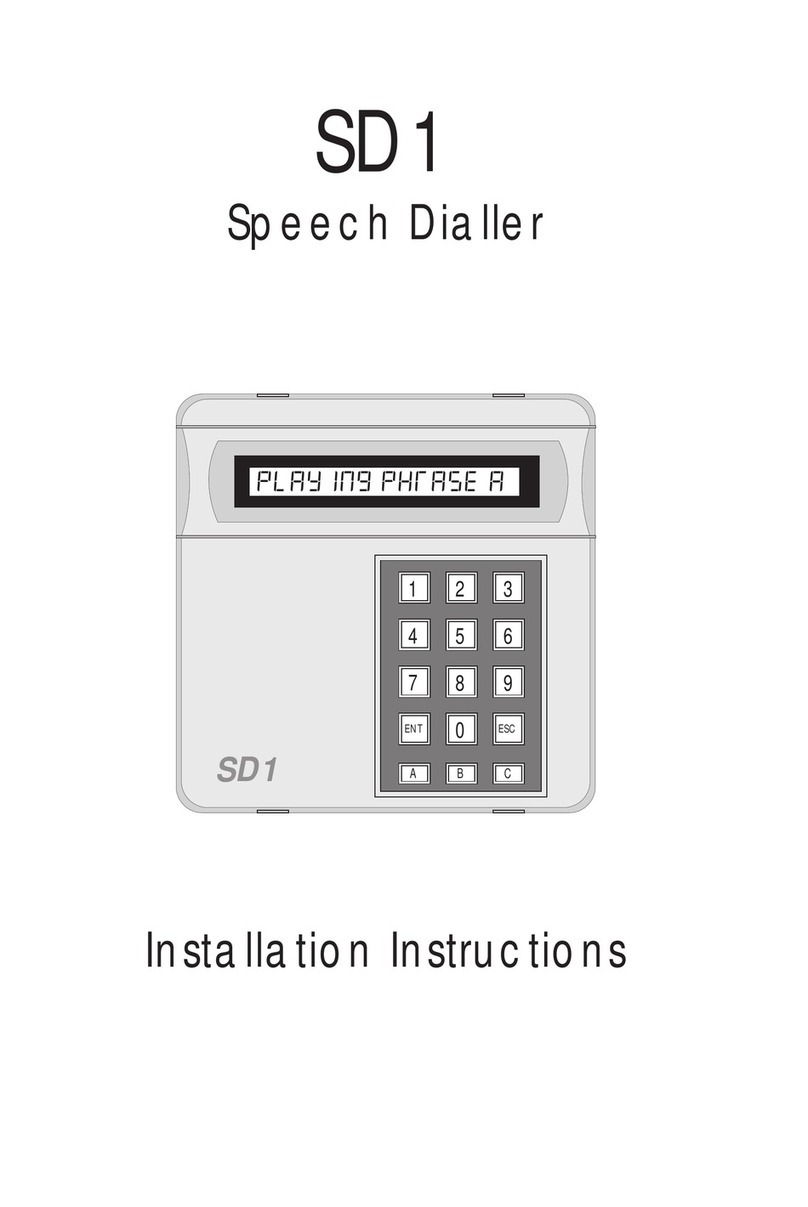
Menvier Security
Menvier Security SD1 User manual

Menvier Security
Menvier Security TS2500 Assembly instructions

Menvier Security
Menvier Security SD1 User manual

